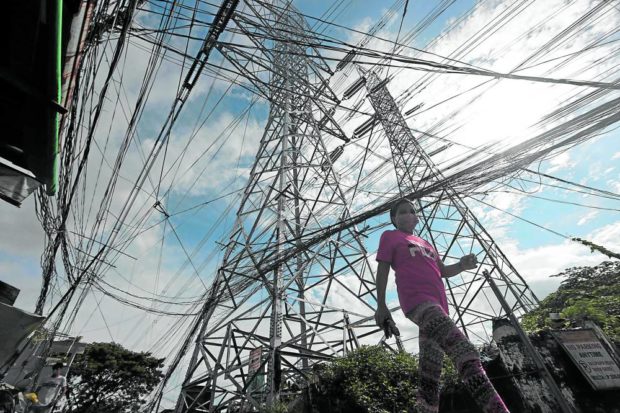MANILA, Philippines — Several areas in Luzon experienced rotating brownouts starting Sunday after the electricity supply plummeted due to the shutdown of seven power plants and the lower output from three other facilities.
The power interruptions were experienced in the provinces of Nueva Ecija, Aurora, Pampanga, and Zambales after the National Grid Corporation of the Philippines (NGCP) placed the Luzon grid under red alert on Monday afternoon, heightening the yellow alert status declared in the morning.
A yellow alert is issued when the excess power is insufficient to meet the transmission grid’s regulating and contingency requirements. A red alert is placed under a grid area when the electricity supply is insufficient to meet the demand.
In an advisory, NGCP said the yellow alert was raised between 9 a.m. and 1 p.m. The warning level was elevated to red alert from 1 p.m. to 4 p.m. after NGCP anticipated that demand would outstrip the available generating capacity. It was lifted at 8:01 p.m.
As of 10 a.m. on Monday, the grid’s available capacity stood at 10,727 megawatts (MW) while the peak demand was at 10,585 MW.
According to NGCP, at least 3,627 MW were lost from the grid after seven power plants went on a forced outage. These included power-generating units of GN Power, Calaca, Masinloc, Sual, Quezon Power, and Avion.
Load dropping
Some parts of the provinces of Nueva Ecija and Aurora suffered power interruptions at 7:52 a.m on Sunday due to the automatic load dropping, according to Aurora Electric Cooperative.
In Zambales province, power interruptions were experienced in some parts of the towns of San Marcelino, San Antonio, and Castillejos at 7:52 a.m on Monday.
Two electric cooperatives operating in Quezon province and some areas in the Bicol region had also advised their consumers of power interruption on Monday following NGCP’s alert warning.
The Quezon II Electric Cooperative Inc. (Quezelco), which serves the northern part of Quezon, said the supply of electricity in some towns was interrupted from 3 p.m. to 4 p.m.
Power consumers in Quezon’s fourth district and parts of Bicol were also notified about a power interruption on Monday, according to Quezelco I.
The temporary loss of electricity was also experienced in the town of Del Gallego in Camarines Sur and several villages in Sta. Elena, Camarines Norte.
In Isabela province, the electric cooperative serving 13 towns and two cities announced that San Miguel Corp., its primary electricity supplier, had declared a forced outage at the Sual facility since 8 a.m. on Sunday due to the tripping at its Bolo-Nagsaag power stations.
In Benguet province, the Lamut substation of Benguet Electric Cooperative was affected from 2 p.m. to 4 p.m., causing rotational brownout in parts of the province.
In Ilocos Norte province, fluctuating voltage led to power interruptions on Sunday, according to the local electric cooperative.
TOUGH JOB | Linemen from Manila Electric Co., or Meralco, repair an electric post in a neighborhood in Valenzuela City on Monday. Several areas in Luzon have been experiencing rotating brownouts since Sunday amid the low electricity supply coming from the island’s power plants. (Photo by GRIG C. MONTEGRANDE / Philippine Daily Inquirer)
In Pampanga province, residents of Mabalacat City and the towns of Bacolor, Guagua, Lubao, Floridablanca, Porac, Santa. Rita, and parts of Magalang were warned of possible power outages due to NGCP’s manual load dropping.
Uncertainty
While the Department of Energy (DOE) expects the precarious power supply situation in Luzon to normalize, NGCP thinks otherwise.
“The event is purely resulting from an incident which we are still validating at this time. We are looking forward to the normalization of the Luzon grid within today,” said Mario Marasigan, director of the DOE’s electric power industry management bureau.
But NGCP spokesperson Cynthia Alabanza said this would depend on certain factors, including the actual consumption and the operation of power plants.
“It really depends if there’s going to be a damp [down] in consumption outside of the expected or if there are going to be additional plants that will go on forced or unscheduled outage or derate (operate below capacity),” Alabanza said in a telephone interview.
Alabanza also noted how the demand situation has shifted over the past years.
“Historically, maybe five years ago, that would have been true, but in the last few years, we’ve seen that demand is also high even during the ‘ber’ months,” she added, referring to the cooler months toward Christmas when demand for electricity declines.
Energy Secretary Raphael Lotilla assured the public that there was no fuel supply constraint amid the “simultaneous forced outages” of several power plants.
“The DOE is verifying the cause of the forced outages… A team from the DOE will conduct actual physical spot checks and validate the condition of the transmission lines and the affected power plants,” Lotilla said in a statement.
—REPORTS FROM VILLAMOR VISAYA JR., YOLANDA SOTELO, JOHN MICHAEL MUGAS, JUN MALIG, TONETTE OREJAS, JOANNA ROSE AGLIBOT, DELFIN MALLARI JR. AND JORDEENE B. LAGARE
RELATED STORIES
Meralco prepares for rotating brownouts due to thinning power supply
Consumers stage protests over brownouts in Occidental Mindoro
Raffy Tulfo vows to go after those behind brownouts in provinces
